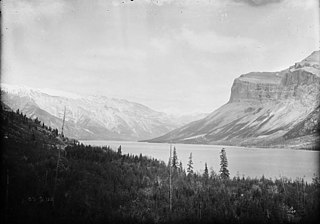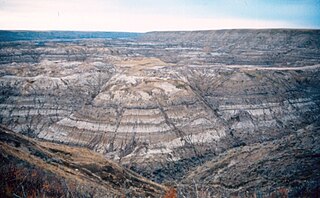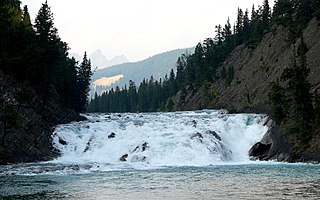Related Research Articles
The American Association of Petroleum Geologists (AAPG) is one of the world's largest professional geological societies with about 17,000 members across 129 countries. The AAPG works to "advance the science of geology, especially as it relates to petroleum, natural gas, other subsurface fluids, and mineral resources; to promote the technology of exploring for, finding, and producing these materials in an economically and environmentally sound manner; and to advance the professional well-being of its members." The AAPG was founded in 1917 and is headquartered in Tulsa, Oklahoma; currently almost one-third of its members live outside the United States.
The Leduc Formation is a stratigraphic unit of Late Devonian (Frasnian) age in the Western Canada Sedimentary Basin. It takes its name from the city of Leduc, and it was formally described from the B.A. Pyrz No. 1 well in central Alberta, between the depths of 1,623.7 m (5,327 ft) and 1,807.5 m (5,930 ft), by Imperial Oil Limited in 1950. Supplementary information came from a complete section of the formation that was cored in Imperial Oil's Leduc No. 530 well between 1,633 m (5,358 ft) and 1,863 m (6,112 ft).
The Mannville Group is a stratigraphical unit of Cretaceous age in the Western Canadian Sedimentary Basin.

The Palliser Formation is a stratigraphic unit of Late Devonian (Famennian) age in the Western Canada Sedimentary Basin. It is a thick sequence of limestone and dolomitic limestone that is present in the Canadian Rockies and foothills of western Alberta. Tall cliffs formed of the Palliser Formation can be seen throughout Banff and Jasper National Parks.
The Beaverhill Lake Group is a geologic unit of Middle Devonian to Late Devonian age in the Western Canada Sedimentary Basin that is present in the southwestern Northwest Territories, northeastern British Columbia and Alberta. It was named by the geological staff of Imperial Oil in 1950 for Beaverhill Lake, Alberta, based on the core from a well that they had drilled southeast of the lake, near Ryley, Alberta.
The Duvernay Formation is a stratigraphical unit of Frasnian age in the Western Canadian Sedimentary Basin.

Within the earth science of geology, the Edmonton Group is a Late Cretaceous to early Paleocene stratigraphic unit of the Western Canada Sedimentary Basin in the central Alberta plains. It was first described as the Edmonton Formation by Joseph Burr Tyrrell in 1887 based on outcrops along the North Saskatchewan River in and near the city of Edmonton. E.J.W. Irish later elevated the formation to group status and it was subdivided into four separate formations. In ascending order, they are the Horseshoe Canyon, Whitemud, Battle and Scollard Formations. The Cretaceous-Paleogene boundary occurs within the Scollard Formation, based on dinosaurian and microfloral evidence, as well as the presence of the terminal Cretaceous iridium anomaly.
Caswell Silver was an American geologist and entrepreneur who was President of Sundance Oil Company from 1960 to 1984. In addition to the business of oil and gas exploration, he was active in the American Association of Petroleum Geologists and published original research on petroleum geology. He endowed the Caswell Silver Foundation at the University of New Mexico.

The Gog Group is a stratigraphic unit in the Western Canada Sedimentary Basin. It is present in the eastern and western main ranges of the Canadian Rockies in Alberta and British Columbia. It was named by C.F. Deiss in 1940 after Gog Lake near its type locality at Wonder Pass near Mount Assiniboine.
The Alexo Formation a stratigraphic unit of Late Devonian age. It is present on the western edge of the Western Canada Sedimentary Basin in the central Rocky Mountains and foothills of Alberta. The formation consists primarily of dolomite. It is locally fossiliferous and includes remains of marine animals such as brachiopods and conodonts.

The Cairn Formation is a geologic formation of Late Devonian (Frasnian) age in the Western Canada Sedimentary Basin. It was named for the Cairn River near its junction with the Southesk River in Jasper National Park by D.J. McLaren in 1955.
The Whitemud Formation is a geologic formation of Late Cretaceous (Maastrichtian) age in the Western Canada Sedimentary Basin. it is present through the plains of southern Saskatchewan, southeastern Alberta and south-central Alberta. Named by N.B. Davis in 1918, the formation is characterized by white kaolinitic clay and is a source of high-quality refractory clay. The type locality has been designated as Dempster's clay pit northwest of Eastend, Saskatchewan.
The Kootenay Group, originally called the Kootenay Formation, is a geologic unit of latest Jurassic to earliest Cretaceous age in the Western Canada Sedimentary Basin that is present in the southern and central Canadian Rockies and foothills. It includes economically important deposits of high-rank bituminous and semi-anthracite coal, as well as plant fossils and dinosaur trackways.
The La Loche Formation is a geologic formation of early Middle Devonian (Eifelian) age in the Western Canada Sedimentary Basin. It is present in northeastern Alberta and northwestern Saskatchewan and was first described by A. W. Norris in 1963, who named it for a Roman Catholic Mission at Lac La Loche. Its type section is located at Contact Rapids on the Clearwater River in Saskatchewan, northwest of Lac La Loche. It is not fossiliferous.

The Spray River Group is a stratigraphic unit of Triassic age. It is present on the western edge of the Western Canada Sedimentary Basin in the foothills and Rocky Mountains of western Alberta. It was originally described as the Spray River Formation by E.M. Kindle in 1924 and was later raised to group status. Its type section is located in the Spray River gorge at the southern end of Sulphur Mountain.
The Purcell Supergroup is composed primarily of argillites, carbonate rocks, quartzites, and mafic igneous rocks of late Precambrian (Mesoproterozoic) age. It is present in an area of about 15,000 km2 (5,800 sq mi) in southwestern Alberta and southeastern British Columbia, Canada, and it extends into the northwestern United States where it is called the Belt Supergroup. It was named for the Purcell Mountains of British Columbia by R.A. Daly in 1912. Fossil stromatolites and algal structures are common in some of the Purcell Supergroup rocks, and the Sullivan ore body at Kimberley, British Columbia, a world-class deposit of lead, zinc, and silver, lies within the Alderidge Formation in the lower part of the Purcell.
The Spray Lakes Group is a stratigraphic unit that is present on the western edge of the Western Canada Sedimentary Basin in the southern Canadian Rockies, and it comprises the Pennsylvanian-age strata of that region. It was named after the Spray Lakes near Banff, Alberta, and fossils of marine invertebrates are found in some of its strata.

The Pika Formation is a stratigraphic unit of Middle Cambrian age that is present on the western edge of the Western Canada Sedimentary Basin in the Canadian Rockies of Alberta and British Columbia. It was named for Pika Peak near Lake Louise in Banff National Park by C.F. Deiss in 1939. It is fossiliferous and preserves several genera of trilobites. Outcrops of the Pika Formation can be seen in Banff and Jasper National Parks.
The Owen Creek Formation is a stratigraphic unit of Middle Ordovician age. It is present on the western edge of the Western Canada Sedimentary Basin in the Canadian Rockies of Alberta and British Columbia. It consists primarily of dolomite and was named for Owen Creek near Mount Wilson in Banff National Park by B.S. Norford in 1969.
Debra Kimiko Nishida was a geologist at Dome Petroleum and a member of the Canadian Energy Geoscience Association since 1980. Dome Petroleum Limited was a petroleum company that was active from 1950 until 1988, when it was purchased by Amoco, which is a chain of gas stations that has been operating in the United States since 1998.
References
- ↑ "Canada Region of AAPG". Affiliated Societies of AAPG by Region. AAPG. Retrieved 4 February 2014.
- 1 2 CSPG. "CSPG History" (PDF). Retrieved 2009-05-16.
- ↑ Bulletin of Canadian Petroleum Geology. Canadian Society of Petroleum Geologists. ISSN 0007-4802.
- ↑ Alberta Geological Survey. "Message from the Canadian Society of Petroleum Geologists" . Retrieved 2009-05-16.